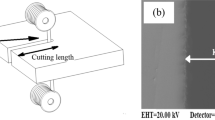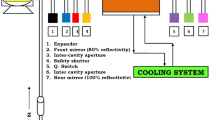Abstract
Due to the poor machinability and weldability of nickel-titanium (NiTi) shape memory alloy, application of NiTi alloy components prepared by smelting technology has been limited in aerospace and other fields. Laser metal deposition (LMD) technology opens a new way for the fabrication of NiTi alloy components. However, deposition quality and deposition rate are significantly influenced by the employed LMD process parameters. In this work, a small-sample prediction and optimization model based on BP-GA neural network for LMD process parameters selection was developed to improve the deposition quality and deposition rate of NiTi alloy components. The initial step involved the design of a central composite experiments consisted of thirty small-sample single-track experiments and building of the prediction model for deposition quality and deposition rate, wherein the inputs were consisted of the process parameters such as the laser power, scanning speed, and powder feeding rate. The responses, on the other hand, included the microhardness, roughness, and deposition rate. Prediction of the single-track cladding results by regression models of the response surface methodology, the ML models of back propagation neural network and random forest algorithms were comparatively analyzed and the prediction model was established. Then, based on the prediction model, non-dominated sorting genetic algorithm-II algorithm was applied to optimize the three input process parameters with the multi-objective of maximizing microhardness and deposition rate, and minimizing roughness. And the optimal combination of process parameters was obtained as a laser power of 1292.14 W, a scanning speed of 8.79 mm/s and a powder feeding rate of 16.78 g/min. Finally, single-track deposition experiments under the optimal combination of process parameters were carried out. The results showed that microhardness of 267.01 (5.23% improvement) and roughness of 7.86 µm (20.04% improvement) was achieved while maintaining a high deposition rate of 36.45 mm3/s. Objective of this study was to improve the deposition quality of NiTi alloy components with high deposition rate.












Similar content being viewed by others
References
Elahinia M, ShayestehMoghaddam N, Taheri Andani M, Amerinatanzi A, Bimber BA, Hamilton RF (2016) Fabrication of NiTi through additive manufacturing: A review. Progress Mater Sci 83:630–663
Bhardwaj A, Ojha M, Garudapalli A, Gupta AK (2021) Microstructural, mechanical and strain hardening behaviour of NiTi alloy subjected to constrained groove pressing and ageing treatment. J Mater Process Technol 294:117132
Elahinia MH, Hashemi M, Tabesh M, Bhaduri SB (2012) Manufacturing and processing of NiTi implants: A review. Prog Mater Sci 57(5):911–946
Mehrpouya M, Gisario A, Elahinia M (2018) Laser welding of NiTi shape memory alloy: A review. J Manuf Process 31:162–186
Elahinia MH (2016) Shape memory alloy actuators design, fabrication, and experimental evaluation. Wiley, Ltd., United Kingdom
Kaya E, Kaya İ (2018) A review on machining of NiTi shape memory alloys: the process and post process perspective. Int J Adv Manuf Technol 100(5–8):2045–2087
Tseng S-F, Hung T-Y, Chang C-M (2022) Mechanical and microstructural properties of additively manufactured Ti–6Al–4 V stents with CO2 laser postannealing treatment. Int J Adv Manuf Technol 119(9–10):6571–6581
Tseng S-F, Wang IH, Chang C-M, Lee C-C, Yeh D-Y, Chen T-W, Yeh A-C (2022) Mechanical characteristic comparison of additively manufactured Ti–6Al–4V lattice structures in biocompatible bone tissue growth. Mater Sci Eng, A 857:144045
Tseng S-F, Chen Y-S (2021) Surface microtexturing of Ti-6Al-4V and SS316L alloys using high pulsed fiber lasers for improving the adhesive bonded performance. Opt Laser Technol 143:107349
Bi G, Gasser A, Wissenbach K, Drenker A, Poprawe R (2006) Characterization of the process control for the direct laser metallic powder deposition. Surf Coat Technol 201(6):2676–2683
Meng L, McWilliams B, Jarosinski W, Park H-Y, Jung Y-G, Lee J, Zhang J (2020) Machine Learning in Additive Manufacturing: A Review. Jom 72(6):2363–2377
Shi G, Li L, Yu Z, Liu R, Sha P, Xu Z, Guo Y, Xi R, Liu J, Xin R, Chen L, Wang X, Zhang Z (2022) The interaction effect of process parameters on the phase transformation behavior and tensile properties in additive manufacturing of Ni-rich NiTi alloy. J Manuf Process 77:539–550
Wang G, Huang L, Liu Z, Qin Z, He W, Liu F, Chen C, Nie Y (2020) Process optimization and mechanical properties of oxide dispersion strengthened nickel-based superalloy by selective laser melting. Mater Des 188:108418
Binbin S, Zhehan C (2021) Defect detection method of powder bed based in image feature fusion. Acta Aeronautica et Astronautica Sinica 524430:427–438
Zhan Z, Hu W, Meng Q (2021) Data-driven fatigue life prediction in additive manufactured titanium alloy: A damage mechanics based machine learning framework. Eng Fract Mech 252:107850
Wu Q, Mukherjee T, De A, DebRoy T (2020) Residual stresses in wire-arc additive manufacturing – Hierarchy of influential variables. Addit Manuf 35:101355
Gao J, Wang C, Hao Y, Liang X, Zhao K (2022) Prediction of TC11 single-track geometry in laser metal deposition based on back propagation neural network and random forest. J Mech Sci Technol 36(3):1417–1425
Gao J, Wang C, Hao Y, Wang X, Zhao K, Ding X (2022) Prediction of molten pool temperature and processing quality in laser metal deposition based on back propagation neural network algorithm. Opt Laser Technol 155:108363
Mehrpouya M, Gisario A, Rahimzadeh A, Nematollahi M, Baghbaderani KS, Elahinia M (2019) A prediction model for finding the optimal laser parameters in additive manufacturing of NiTi shape memory alloy. Int J Adv Manuf Technol 105(11):4691–4699
Mehrpouya M, Gisario A, Nematollahi M, Rahimzadeh A, Baghbaderani KS, Elahinia M (2021) The prediction model for additively manufacturing of NiTiHf high-temperature shape memory alloy. Mater Today Commun 26:102022
Shamsaei N, Yadollahi A, Bian L, Thompson SM (2015) An overview of Direct Laser Deposition for additive manufacturing Part II: Mechanical behavior, process parameter optimization and control. Addit Manuf 8:12–35
Han J, Yang J, Yu H, Yin J, Gao M, Wang Z, Zeng X (2017) Microstructure and mechanical property of selective laser melted Ti6Al4V dependence on laser energy density. Rapid Prototyp J 23(2):217–226
He Y, Montgomery C, Beuth J, Webler B (2019) Melt pool geometry and microstructure of Ti6Al4V with B additions processed by selective laser melting additive manufacturing. Mater Des 183:108126
Xue L, Atli KC, Picak S, Zhang C, Zhang B, Elwany A, Arroyave R, Karaman I (2021) Controlling martensitic transformation characteristics in defect-free NiTi shape memory alloys fabricated using laser powder bed fusion and a process optimization framework. Acta Materialia 215:117017
Xue P, Zhu L, Xu P, Ren Y, Xin B, Meng G, Yang Z, Liu Z (2021) Research on process optimization and microstructure of CrCoNi medium-entropy alloy formed by laser metal deposition. Opt Laser Technol 142:107167
Xin B, Zhou X, Gong Y (2020) Surface based variable thickness slicing modeling for laser metal deposition. Int J Adv Manuf Technol 107(1–2):463–474
Cao L, Li J, Hu J, Liu H, Wu Y, Zhou Q (2021) Optimization of surface roughness and dimensional accuracy in LPBF additive manufacturing. Opt Laser Technol 142:107246
Peng S, Li T, Zhao J, Lv S, Tan GZ, Dong M, Zhang H (2019) Towards energy and material efficient laser cladding process: Modeling and optimization using a hybrid TS-GEP algorithm and the NSGA-II. J Clean Prod 227:58–69
Matos MA, Rocha AMAC, Costa LA (2020) Many-objective optimization of build part orientation in additive manufacturing. Int J Adv Manuf Technol 112(3–4):747–762
Li J, Hu J, Cao L, Wang S, Liu H, Zhou Q (2021) Multi-objective process parameters optimization of SLM using the ensemble of metamodels. J Manuf Process 68:198–209
Asadollahi-Yazdi E, Gardan J, Lafon P (2018) Multi-Objective Optimization of Additive Manufacturing Process, 16th IFAC Symposium on Information Control Problems in Manufacturing (INCOM), Elsevier Science Bv, Bergamo, ITALY, pp 152–157
Khodaygan S, Golmohammadi AH (2017) Multi-criteria optimization of the part build orientation (PBO) through a combined meta-modeling/NSGAII/TOPSIS method for additive manufacturing processes. Int J Interact Design Manuf (IJIDeM) 12(3):1071–1085
Miao P, Niu F, Ma G, Lü J, Wu D (2017) Effect of deposition efficiency on microstructure and property of 316L stainless steel fabricated by laser engineered net shaping. Opto-Electron Eng 44(4):412–417
Yuan L, Gu D, Lin K, Dai D, Yang J, Huang G, Xiong K (2022) Laser-Directed Energy Deposition Additive Manufacturing of Nickel-Titanium Coatings: Deposition Morphology, Microstructures, and Mechanical Properties. Adv Eng Mater 25(2):2200965
Zhang Y, Yan W (2022) Applications of machine learning in metal powder-bed fusion in-process monitoring and control: status and challenges. J Intell Manuf 34(6):2557–2580
Karimifard S, AlaviMoghaddam MR (2018) Application of response surface methodology in physicochemical removal of dyes from wastewater: A critical review. Sci Total Environ 640–641:772–797
Nguyen DTC, Vo D-VN, Nguyen TT, Nguyen TTT, Nguyen LTT, Tran TV (2022) Optimization of tetracycline adsorption onto zeolitic–imidazolate framework-based carbon using response surface methodology. Surf Interfaces 28:101549
Kumar M, Dahuja A, Tiwari S, Punia S, Tak Y, Amarowicz R, Bhoite AG, Singh S, Joshi S, Panesar PS, Prakash Saini R, Pihlanto A, Tomar M, Sharifi-Rad J, Kaur C (2021) Recent trends in extraction of plant bioactives using green technologies: A review. Food Chem 353:129431
Jaafari J, Yaghmaeian K (2019) Optimization of heavy metal biosorption onto freshwater algae (Chlorella coloniales) using response surface methodology (RSM). Chemosphere 217:447–455
Zhou Z (2016) Maching learning. Tsinghua University Press
MATLAB Chinese Forum (2010) MATLAB Neural Network 30 case analysis, pp 1–32
Liu L, Chen J, Xu L (2008) Realization and Application Research of BP Neural Network Based on MATLAB. Int Semin Futur BioMed Inf Eng 2008:130–133
Zhang X, Li W, Chen X, Cui W, Liou F (2017) Evaluation of component repair using direct metal deposition from scanned data. Int J Adv Manuf Technol 95(9–12):3335–3348
Deb K, Pratap A, Agarwal S, Meyarivan T (2002) A fast and elitist multiobjective genetic Algorithm. IEEE Trans Evol Comput 6:182–197
Funding
This work was supported by the Sponsored by National Natural Science Foundation of China (52075341), International Science & Technology Cooperation Program of Shanghai (21510731500) and Shanghai Sailing Program(21YF1418000).
Author information
Authors and Affiliations
Contributions
Jiali Gao: Conceptualization, Methodology, Writing- Review & Editing. Xu Wang: Data curation, Software, Writing- Original draft. Chi Wang: Software. Yunbo Hao: Validation. Xudong Liang: Software. Weiqi Li: Investigation. Kai Zhao: Supervision, Funding acquisition.
Corresponding author
Ethics declarations
Competing interests
The authors declare no competing interests.
Additional information
Publisher's note
Springer Nature remains neutral with regard to jurisdictional claims in published maps and institutional affiliations.
Rights and permissions
Springer Nature or its licensor (e.g. a society or other partner) holds exclusive rights to this article under a publishing agreement with the author(s) or other rightsholder(s); author self-archiving of the accepted manuscript version of this article is solely governed by the terms of such publishing agreement and applicable law.
About this article
Cite this article
Gao, J., Wang, X., Wang, C. et al. Multi-objective optimization of process parameters for laser metal deposition of NiTi shape memory alloy based on neural network and genetic algorithm. Int J Adv Manuf Technol 130, 4663–4678 (2024). https://doi.org/10.1007/s00170-024-12974-5
Received:
Accepted:
Published:
Issue Date:
DOI: https://doi.org/10.1007/s00170-024-12974-5




